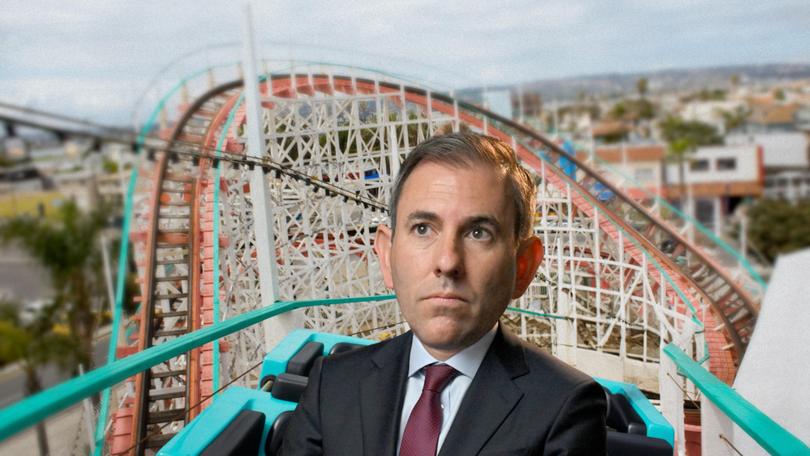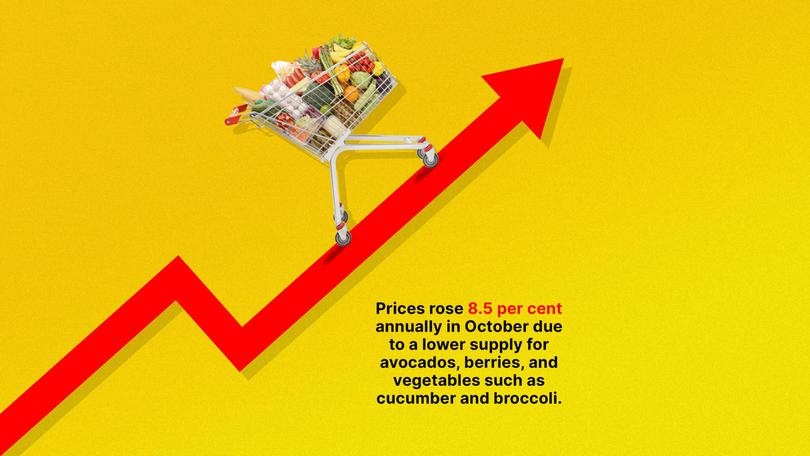JACKSON HEWETT: No getting off Jim Chalmers’ wild inflation ride as prices continue rise outside RBA’s targets

Sometime in the middle of next year, the world’s tallest and fastest roller coaster will open in Saudi Arabia.
Topping out at the height of a 60-storey building and with a top speed of 250km/h, the experience will be the equivalent of driving an F1 car out the observation deck of Sydney’s Centrepoint tower.
Dubbed Falcon’s Flight, the ride is classified as an extreme thrill that delivers intense G-forces.
Sign up to The Nightly's newsletters.
Get the first look at the digital newspaper, curated daily stories and breaking headlines delivered to your inbox.
By continuing you agree to our Terms and Privacy Policy.I won’t be buying a ticket.
Nor I expect, will Australia’s struggling mortgage holders or benighted businesses.
They have their own thrill ride watching inflation tumble, then tip back up again which means that barring some catastrophe, Falcon’s Flight will be up and running by the time the Reserve Bank cuts rates.
Until then, struggling Australians will be under the crushing G-forces of an economy that barely sputters along, and is going backwards if you calculate it as GDP per capita.
While only monthly, today’s inflation figures took off in the wrong direction.
The main figure that the Reserve Bank cares about, underlying inflation, rose to 3.5 per cent year on year. Last month, that figure was 3.2 per cent and was edging down towards the 2 to 3 per cent target band that would have given the RBA’s board room to think about cutting rates.
Minutes from the last interest rate meeting showed that last quarter’s moderation in inflation had to hold if they were to be confident it was being defeated. The Reserve Bank board needed to see “more than one good quarterly inflation outcome to be confident that such a decline in inflation was sustainable,” the minutes said.
The problem is services inflation. Prices grew by 4.8 per cent year on year and reflect what is happening in the domestic economy.
Cost pressure like wages, or an absence of competitive pressure are flowing through to the paying public. That saw inflation rise for insurance and financial services, and moderate only fractionally for education, with both sectors growing prices at 6.3 per cent annually.
Christian Baylis, chief investment officer for Fortlake Asset Management, and a former RBA economist said the figures were not positive for a rate cut.
“Sticky underlying services inflation is ruining the party for the RBA,” he said.
“The RBA are really starting to look like the one of the few central banks that will be able to cut anytime soon.”
Luci Ellis, group chief economist for Westpac and a former assistant governor at the RBA was more optimistic. Westpac pushed their rate cut forecast from February to May last week and Ms Ellis said that the numbers weren’t particularly view changing in terms of that forecast.
“It is a bit of a mixed bag but inflation is coming down broadly across the range,” she said. “The reality is a material slowing of inflation.”
Cost of living
From the Government’s perspective, the challenge is whether consumers see it that way.
The figures also showed how tough things are becoming for everyday Australians with the cost of fruit and vegetables soaring in October. Prices rose 8.5 per cent annually in October due to a lower supply for avocados, berries, and vegetables such as cucumber and broccoli.
Food prices overall rose by 3 per cent with rises in the price of bread and cereals, meat and seafood and, and non-alcoholic beverages.

With question after question from the Opposition on whether Australians were better off under Labor, it’s no wonder that Anthony Albanese used time in Parliament today to talk up more penalties for supermarkets including fines of up to $10 million for price gouging.
“People trying hard to find good prices don’t deserve to be ripped off,” he thundered, looking to ward off Coalition attacks on how consumers are doing it tough.
Consumers would be doing it tougher were it not for the energy rebates.
State and Federal rebates have helped drive energy prices down by 35.6 per cent in the 12 months to October, the largest fall on record.
Excluding these rebates, electricity costs for households would have increased 16.1 per cent since June 2023.
Unfortunately the big fall in energy costs will be “looked through” by the RBA, meaning they won’t help in their inflation calculations.
Housing costs are another area where growing costs are fuelling growing consumer anger.
But it looks like rent rises are moderating, showing a modest fall of 0.3 per cent month on month to 6.7 per cent annually.
Here Government handouts have pushed down the headline rate thanks to a 10 per cent increase in government rent assistance.
Rent prices would have increased 0.5 per cent otherwise due to low vacancy rates and tight rental markets in most capital cities.
The brightest spot might be in housing where new dwelling prices were effectively flat at 4.2 per cent annual inflation.
That index has steadily fallen since a peak of 21.7 per cent in July 2022 as supply chain bottlenecks drove up the price of new houses. Separate data from the ABS showed housing construction rose to a three-year high in the September quarter.
Another bright spot for consumers was fuel prices, which fell 11.5 per cent on an annualised basis in October. Fuel prices were growing at 10 per cent as early as May, but a slowing global economy has crimped fuel demand, while US production has stayed high. That has helped push the price of oil down.
Global wild-card
With a tariff wielding president-elect Donald Trump about to take office, the global picture is the wild-card in the inflationary deck.
Yesterday, Mr Trump declared he would put a 25 per cent tariff on both Mexico and Canada, and an additional 10 per cent tariff on imports from China.
Those policies would be inflationary for America, resulting in a higher US dollar and a lower Australian dollar.
A low dollar in Australia would likely raise the price of imported goods here and flow through to the inflation figures that are closely watched by the RBA.
“Australia dollar weakness is yet to play into these numbers on tradeables (import) inflation which is 40 per cent of the the CPI basket,” Mr Baylis said. “We are still to digest the post US-election fall in the Aussie dollar.”
Expect the wild inflation ride to continue.

